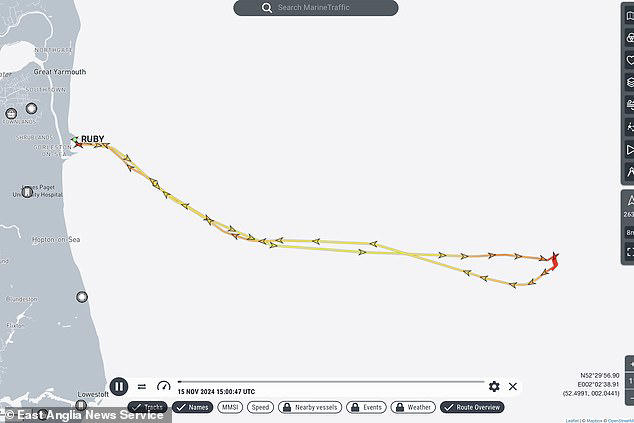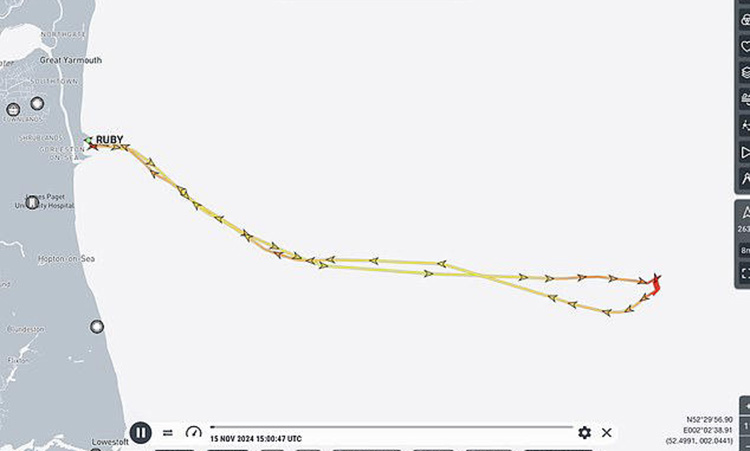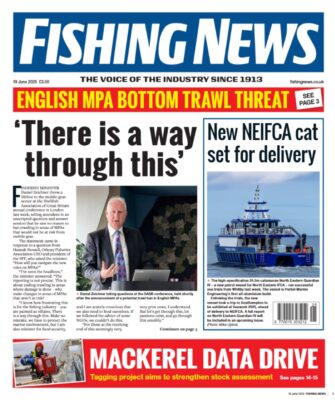An unknown but reportedly ‘huge’ quantity of fertiliser was dumped off the east coast of England last week, sparking concerns about the impact on local ecosystems and fisheries.
In an operation ultimately approved and co-ordinated by the transport minister, the Maltese-registered cargo vessel Ruby, which was carrying 20,000t of ammonium nitrate, was seen on AIS repeatedly circling a small area for 30 hours as it discharged part of its cargo just outside the 12-mile limit.
The discharges were permitted due to safety concerns over the poorly stored chemical, which can be used both as a fertiliser, and in the manufacture of explosives. Concern over the safety of the cargo, originally from Russia, has been such that the vessel has repeatedly been denied access to ports across western Europe and the Baltic, having attempted to land into both Norway and Lithuania but refused port entry on both occasions.
The vessel was finally given permission to dock in Great Yarmouth and transfer its cargo, after months of searching for a suitable berth. However, after contamination of the cargo was discovered, increasing the risks of a devastating explosion – bigger than a similar one which ripped through Beirut harbour in 2020, killing 218 people – permission was given to discard the affected portion of the cargo.
Ammonium nitrate is widely used as a farm fertiliser. Run-off of nitrates from agricultural use is blamed for widespread algal blooms inshore, with a number of land-based Special Protection Areas, with marine components, designated in an attempt to reduce nitrate pollution.
Ammonium nitrate is highly soluble in seawater and can cause huge algal blooms at sea, that can die and rot on the seabed after the fertiliser has been fully taken up, depleting the sea of oxygen and killing seabed organisms. It can also be absorbed directly by fish, damaging nervous systems and hampering their ability to breathe.
The ‘good news’ as far as pollution is concerned is that the discharge happened during the winter, with short day lengths hampering the potential for algal blooms while the chemical is dispersed by the tide.
A spokesman for Peel Ports, which operates the outer harbour at Great Yarmouth, refused to confirm or deny if ammonium nitrate had been dumped at sea, saying it could not comment on anything that did not happen in the port.
FN contacted the MMO, the body responsible for providing consent to discharge material into the sea, the Cefas marine laboratory in nearby Lowestoft and Eastern IFCA (EIFCA) with a number of questions about the volumes of fertiliser discharged, any rules about where, and under what tidal conditions, it could be discharged, and whether this took place within or close to the MPAs off the Suffolk coast.

The AIS track of the MV Ruby during the discharge operation.
The MMO confirmed that the operation was jointly handled between it, the Department for Transport and the MCA.
In a joint response to FN, the organisations failed to answer the questions we had put to them about the volume discharged, any conditions applied to the vessel and why the discharge over a 30- hour period took place in such a small area.
The statement FN received on behalf of the three organisations said simply: “The port and ship operator have carried out an operation, with advice from the Maritime and Coastguard Agency, the Health and Safety Executive and environmental regulators. All are content that the MV Ruby and its cargo meet safety standards.
“We continue to support the agencies involved, as well as the local authority.”
EIFCA confirmed that it had been part of the East of England Standing Environment Group, chaired by the Environment Agency, that meets in emergency situations such as this. It said: “We advised on what we considered the risks might be to the marine environment, marine organisms (including fish stocks) and the inshore fishing industry, and we advocated for a site that minimised such risks, insofar as it was possible to do so.
“Although the deposition site is well outside the authority’s district, we recognise the likely concerns of our stakeholders, including the fishing industry. As a consequence, we are actively supporting the monitoring group through attendance and contribution at meetings and the provision of resources such as vessels to facilitate monitoring activity.”
This story was taken from the latest issue of Fishing News. For more up-to-date and in-depth reports on the UK and Irish commercial fishing sector, subscribe to Fishing News here or buy the latest single issue for just £3.50 here.
Sign up to Fishing News’ FREE e-newsletter here.








